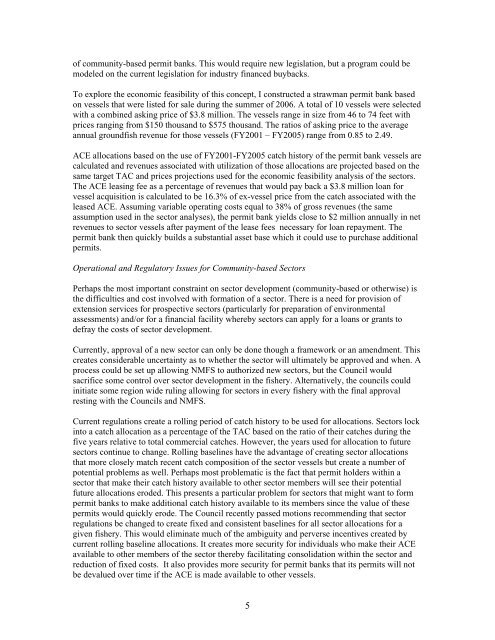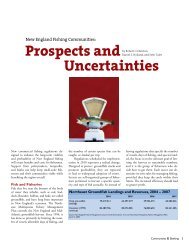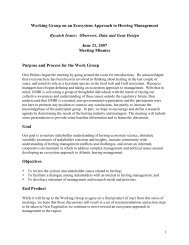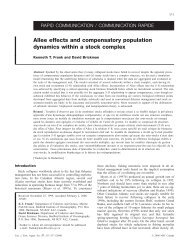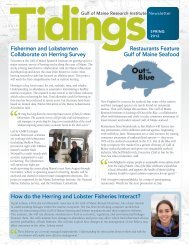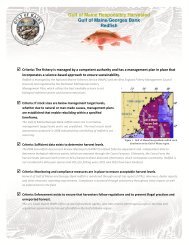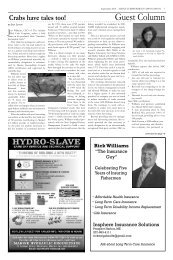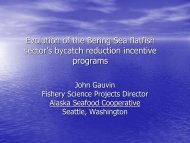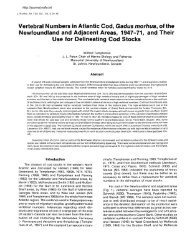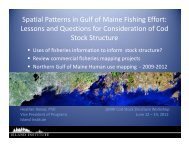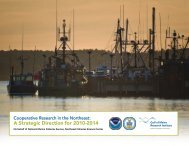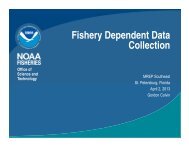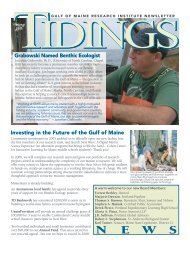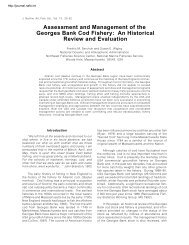Community-based Sectors for the New England Groundfish Fishery
Community-based Sectors for the New England Groundfish Fishery
Community-based Sectors for the New England Groundfish Fishery
Create successful ePaper yourself
Turn your PDF publications into a flip-book with our unique Google optimized e-Paper software.
of community-<strong>based</strong> permit banks. This would require new legislation, but a program could be<br />
modeled on <strong>the</strong> current legislation <strong>for</strong> industry financed buybacks.<br />
To explore <strong>the</strong> economic feasibility of this concept, I constructed a strawman permit bank <strong>based</strong><br />
on vessels that were listed <strong>for</strong> sale during <strong>the</strong> summer of 2006. A total of 10 vessels were selected<br />
with a combined asking price of $3.8 million. The vessels range in size from 46 to 74 feet with<br />
prices ranging from $150 thousand to $575 thousand. The ratios of asking price to <strong>the</strong> average<br />
annual groundfish revenue <strong>for</strong> those vessels (FY2001 – FY2005) range from 0.85 to 2.49.<br />
ACE allocations <strong>based</strong> on <strong>the</strong> use of FY2001-FY2005 catch history of <strong>the</strong> permit bank vessels are<br />
calculated and revenues associated with utilization of those allocations are projected <strong>based</strong> on <strong>the</strong><br />
same target TAC and prices projections used <strong>for</strong> <strong>the</strong> economic feasibility analysis of <strong>the</strong> sectors.<br />
The ACE leasing fee as a percentage of revenues that would pay back a $3.8 million loan <strong>for</strong><br />
vessel acquisition is calculated to be 16.3% of ex-vessel price from <strong>the</strong> catch associated with <strong>the</strong><br />
leased ACE. Assuming variable operating costs equal to 38% of gross revenues (<strong>the</strong> same<br />
assumption used in <strong>the</strong> sector analyses), <strong>the</strong> permit bank yields close to $2 million annually in net<br />
revenues to sector vessels after payment of <strong>the</strong> lease fees necessary <strong>for</strong> loan repayment. The<br />
permit bank <strong>the</strong>n quickly builds a substantial asset base which it could use to purchase additional<br />
permits.<br />
Operational and Regulatory Issues <strong>for</strong> <strong>Community</strong>-<strong>based</strong> <strong>Sectors</strong><br />
Perhaps <strong>the</strong> most important constraint on sector development (community-<strong>based</strong> or o<strong>the</strong>rwise) is<br />
<strong>the</strong> difficulties and cost involved with <strong>for</strong>mation of a sector. There is a need <strong>for</strong> provision of<br />
extension services <strong>for</strong> prospective sectors (particularly <strong>for</strong> preparation of environmental<br />
assessments) and/or <strong>for</strong> a financial facility whereby sectors can apply <strong>for</strong> a loans or grants to<br />
defray <strong>the</strong> costs of sector development.<br />
Currently, approval of a new sector can only be done though a framework or an amendment. This<br />
creates considerable uncertainty as to whe<strong>the</strong>r <strong>the</strong> sector will ultimately be approved and when. A<br />
process could be set up allowing NMFS to authorized new sectors, but <strong>the</strong> Council would<br />
sacrifice some control over sector development in <strong>the</strong> fishery. Alternatively, <strong>the</strong> councils could<br />
initiate some region wide ruling allowing <strong>for</strong> sectors in every fishery with <strong>the</strong> final approval<br />
resting with <strong>the</strong> Councils and NMFS.<br />
Current regulations create a rolling period of catch history to be used <strong>for</strong> allocations. <strong>Sectors</strong> lock<br />
into a catch allocation as a percentage of <strong>the</strong> TAC <strong>based</strong> on <strong>the</strong> ratio of <strong>the</strong>ir catches during <strong>the</strong><br />
five years relative to total commercial catches. However, <strong>the</strong> years used <strong>for</strong> allocation to future<br />
sectors continue to change. Rolling baselines have <strong>the</strong> advantage of creating sector allocations<br />
that more closely match recent catch composition of <strong>the</strong> sector vessels but create a number of<br />
potential problems as well. Perhaps most problematic is <strong>the</strong> fact that permit holders within a<br />
sector that make <strong>the</strong>ir catch history available to o<strong>the</strong>r sector members will see <strong>the</strong>ir potential<br />
future allocations eroded. This presents a particular problem <strong>for</strong> sectors that might want to <strong>for</strong>m<br />
permit banks to make additional catch history available to its members since <strong>the</strong> value of <strong>the</strong>se<br />
permits would quickly erode. The Council recently passed motions recommending that sector<br />
regulations be changed to create fixed and consistent baselines <strong>for</strong> all sector allocations <strong>for</strong> a<br />
given fishery. This would eliminate much of <strong>the</strong> ambiguity and perverse incentives created by<br />
current rolling baseline allocations. It creates more security <strong>for</strong> individuals who make <strong>the</strong>ir ACE<br />
available to o<strong>the</strong>r members of <strong>the</strong> sector <strong>the</strong>reby facilitating consolidation within <strong>the</strong> sector and<br />
reduction of fixed costs. It also provides more security <strong>for</strong> permit banks that its permits will not<br />
be devalued over time if <strong>the</strong> ACE is made available to o<strong>the</strong>r vessels.<br />
5


